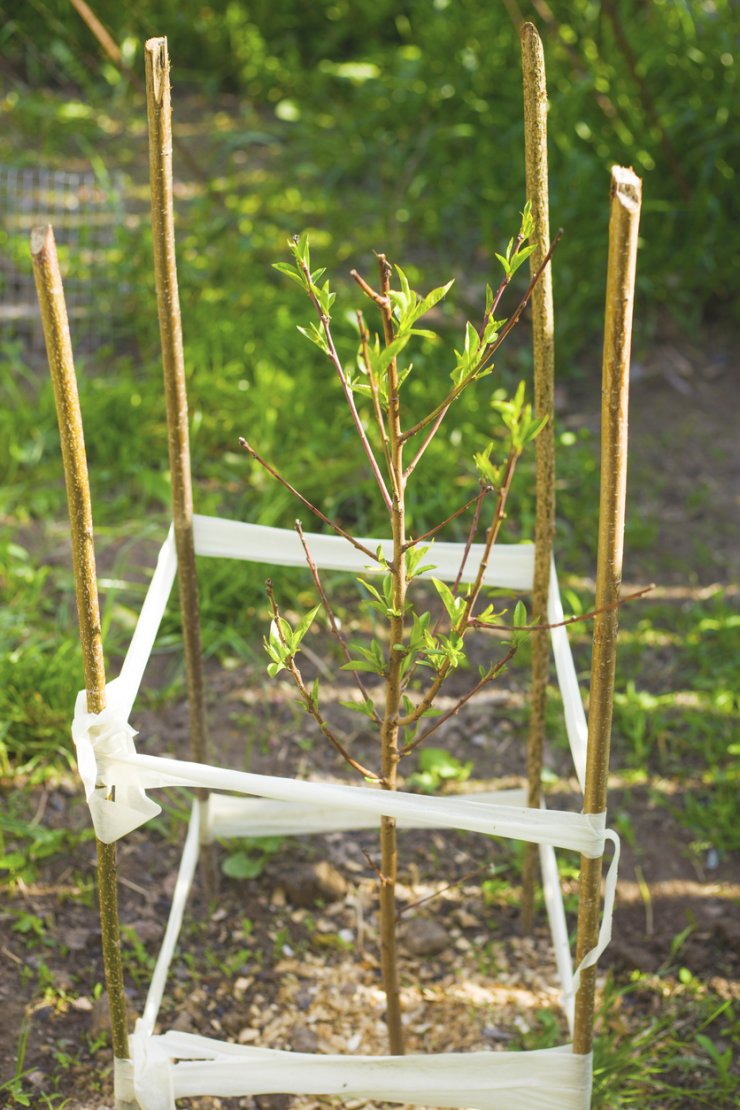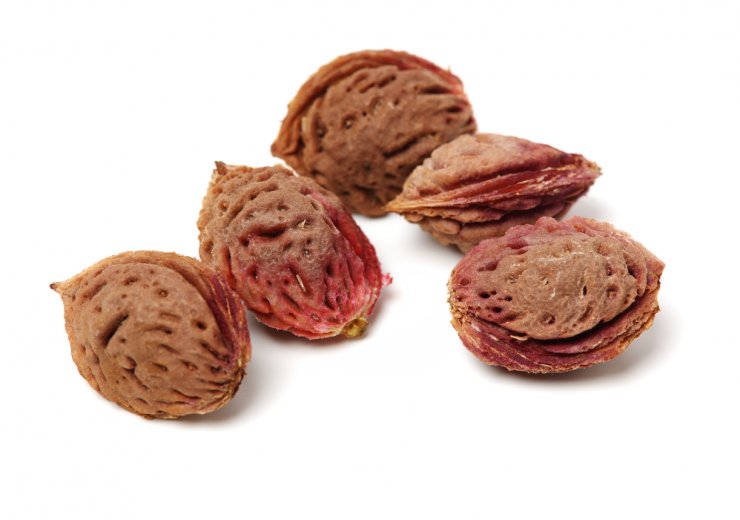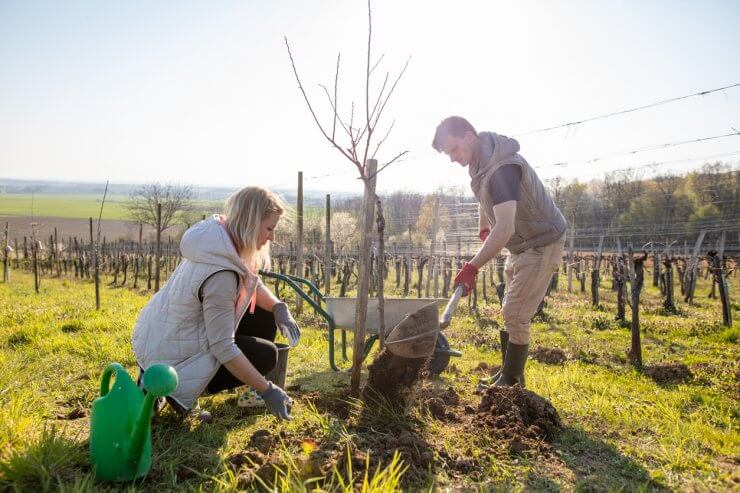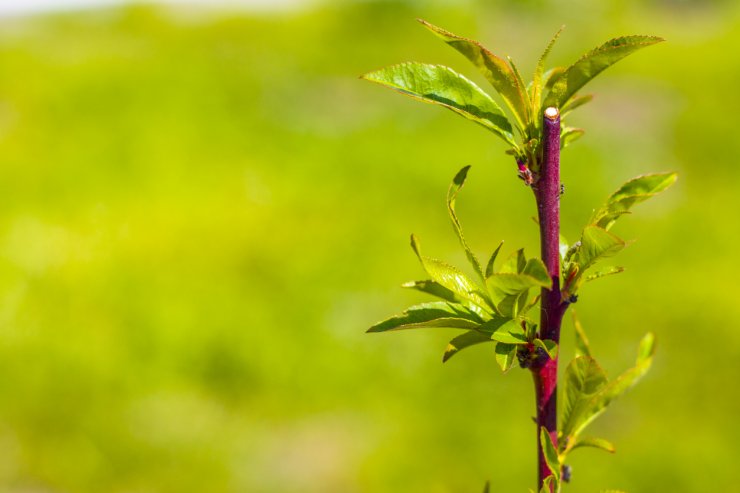
Peach seedling with stake supports.
Your first choice when deciding to grow peaches is whether you want to start with seeds, seedlings, or cuttings. Unlike many other fruits, peaches grown from the seed of standard trees (not grafted) will remain true to the parent.
Before you start, the main thing to remember is that peach trees require at least 600 to 900 chilling hours (25 days) at 45 degrees F or lower to trigger fruiting.
Outside of the usual zones 5 to 8, extended temperatures below zero may damage the trees, and warm climates without the required winter means you won’t get any fruit.
There are some varieties that are hardy in slightly colder or warmer climates, but not much more so. A greenhouse will allow you to grow peaches in containers in really cold climates, but there’s not much you can do if you’re in, say, south Florida, to mimic the winter dormancy period.
Growing your peach trees from seed

Peach seeds.
If you’re in the right climate, you get to start with your choice of seeds, trees, or cuttings. It’s easy to grow peaches from seeds—even if the wait is longer to get your fruit. The seed is found inside the pit we’re all familiar with. But some gardeners simply stick peach pits into the ground in the right zones, or in growing medium in a pot, then let winter do its part (remember, under 45 degrees F, but above zero degrees) and wait for the seedlings to pop up.
Other gardeners have a different method for growing from seed. Instead of letting Mother Nature take care of the matter, they use a tool, such as vise grips, to crush the pit carefully and extract the actual seed from the pit. This can be tricky as you don’t want to harm the seed, especially the pointy part where the roots will begin to grow.
Then, place the seeds inside a folded, wet paper towel, place the towel inside a plastic zip-top bag, and freeze overnight. Once frozen, the plastic bag is placed in the refrigerator for up to four months. This process recreates the stratification process that seeds go through in the ground in nature.
While in the refrigerator, condensation should form inside the plastic bag—this is a good thing! If inside the bag looks dry, you can lightly spray water inside the bag to ensure moistness.
When ready to germinate the seed, remove the pit from the refrigerator and soak it in a small bowl of room-temperature water for three hours. Fill half your zip-top plastic bag with moistened vermiculite—a potent mineral that expands when heated—and put the soaked peach pit in the middle of the vermiculite. Place the bag back in the refrigerator for about 45 days until the peach seed produces a sprouting root that is 1/2-inch long.
Once the seeds sprout, they can be placed in seed-starting mix in pots to await planting time, or in the ground if it’s the right time of year—late winter to very early spring.
Whichever method you choose, growing from seed requires patience as peach trees won’t fruit until the second, third, or even fourth year. Also, most of the peaches you buy are grafted varieties that have two plants for parents, and you never know quite what you’re going to get for children.
Growing your peaches from existing trees

Planting a young tree
The easiest and most commonly used method of growing peaches is growing from a tree you’ve bought from the garden center or online. Choose a tree that is about a year old. A small tree that has a good root system is better than a larger tree without one. This will help you grow a peach tree that is hardy and healthy.
Most trees you buy will be grafted varieties, where a cutting from a specific variety has been grafted onto the rootstock of a particularly hardy type of peach.
You’ll be able to see the graft, which looks like an old scar. When planting, be sure to keep this scar 1 to 2 inches above the soil level, and don’t let it sink below ground level as the young tree grows.
Plant trees in late winter or early spring, depending on where you are, after the snow has melted and snowmelt has dried up. Peaches hate wet feet! Plant a bare root tree as soon as possible, preferably the same day you buy it. For potted or burlap-covered trees, remove the plant from its container and remove any circling roots by laying the root ball on its side and using clean shears to cut through the offending roots—just keep root pruning to a minimum.
Growing your peaches from cuttings

Peach tree cutting growing as new tree.
If you or someone you know already has a healthy tree that produces a good crop, you can take a cutting to start your own tree.
Take a 9-inch softwood cutting in the spring, when growth is soft and green. Dip it in rooting hormone to help the cutting take. Plant the cutting in sterile potting medium, and keep it moist. Roots will form in a month. When you see growth above ground, care for it as you would any seedling and then plant it in a pot or in the ground in late winter to early spring.
Have you tried growing peaches from seeds, seedlings, or cuttings? Which method do you prefer—and why? Please tell us how you get your peaches bearing fruit every year.


 Previous
Previous


Hi Joy.
This is a great question.
There are a few basics guidelines to ensure the best possible crop of peaches. Firstly, you want to make sure that you are practicing good hygiene by keeping your tree and the surrounding area tree clear of debris, weeds and fallen fruit, especially those with signs of disease. Certain fungus can survive the winter on both fruit and in parts of the tree. When you are pruning, always start with clean & disinfected equipment to prevent the spread of disease, then make sure to remove any cankerous parts of the tree that might be harboring fungus. Be vigilant about removing diseased fruit and twigs throughout the growing season and do not compost any diseased plant material. Proper pruning will provide better air circulation and can help prevent some fungal diseases. Similarly, proper watering throughout the growing season can minimize the effects of certain diseases.
If these preventative measures aren’t sufficient to reduce or eliminate the disease then you may need to consider applying a fungicide. There are a variety of fungicides available depending on what’s attacking your peaches. Some of the most common diseases are Brown Rot, Peach Scab, Bacterial Spot and Powdery Mildew. If you chose to use a fungicide, your local gardening center can help you determine the active ingredient best suited for you peach tree variety and the fungus. Keep in mind that you may need several applications and then you’ll likely have to allow for a period of time between application and safe harvest.
This article also provides an alternative to a chemical fungicides that you can try.
https://foodgardening.mequoda.com/articles/prepare-for-peach-diseases-and-pests/?t=395
Last year my peach trees got a fungus on all the fruit. What can I put on them this year to prevent that?